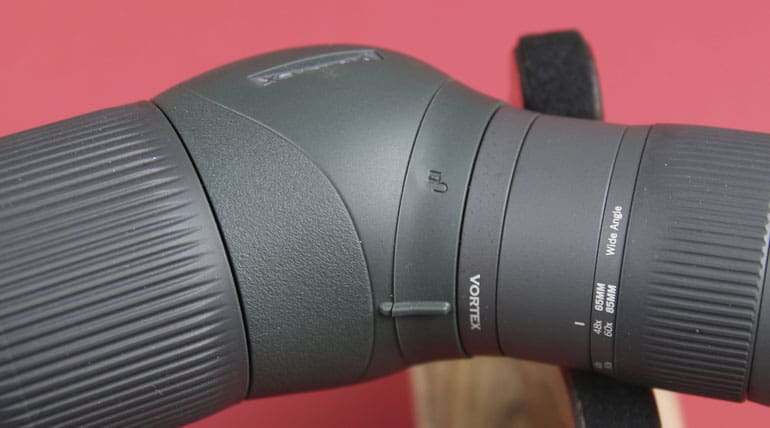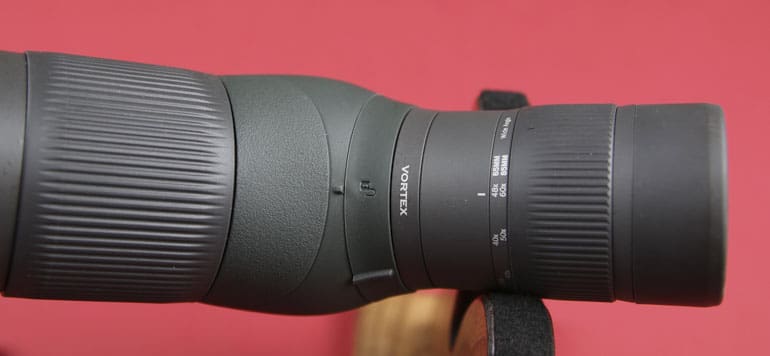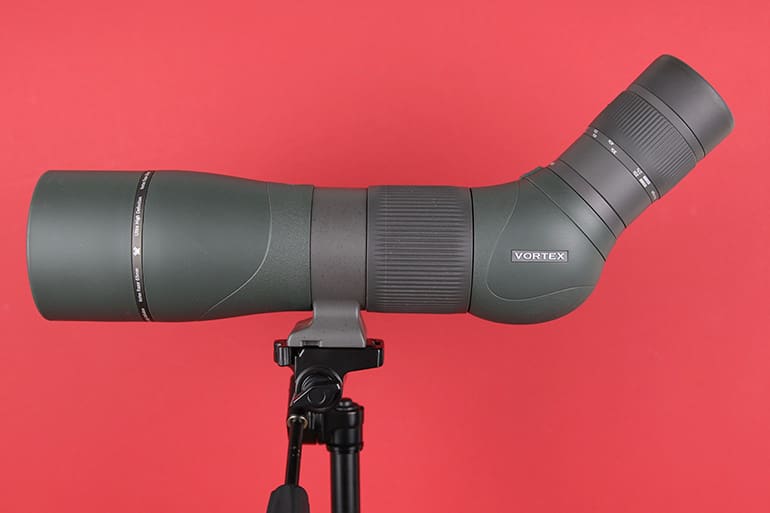I first encountered Vortex Optics spotting scopes at a Government Training Institute – Legion long range shooting course. I’ll be honest and say that ALL of the spotting scopes I used, from a variety of manufacturers, seemed to have great clarity and phenomenal field-of-vision at distances from 70-850 yards.
The only aspect I found difficult was trying to use those spotting scopes that possessed reticles – the markings kept this relative newcomer to long-distance shooting from seeing some of the impacts.
All of the above is to say, when I was asked to review a Delta 5 rifle from Daniel Defense, I wanted a spotting scope that provided great clarity and field-of-view for the longest target distances I’d be shooting (i.e. 700+ yards), but at the same time avoid models equipped with reticles.
I knew that Vortex made such spotting scopes. I also knew that the Vortex Fury Laser Rangefinder I had been sent to use at the GTI course and for hunting (see review), was incredibly clear and easy to use (so good, in fact, that I purchased my own Fury). Vortex recommended the Razor HD 22-48×65 (Angled) model.
The angled eyepiece allows the user to reduce the height of the tripod base. This is actually quite useful in windy conditions, or when sitting in a chair at the range – both conditions encountered during the GTI course and our rifle review.
One other feature that came in handy for our early-morning range session with the Delta 5 was the built-in pull-out sunshade. It allowed us to view the targets when the angle of the sun would causing a glare. Finally, the angled eyepiece combined with the rotating tripod ring provides the ability to rotate the eyepiece to a variety of positions, thus allowing adjustable viewing angles.
Like the Vortex laser rangefinder, the Vortex Razor spotting scope is straightforward to use. The magnification and focus are adjusted using the rings located just below the eyecup and just in front of the tripod mount, respectively.

The eyecup was easily adjusted to accommodate the presence or absence of eyeglasses, and the facial shapes of the spotter, simply by twisting.


The final feature that will come in handy for competitive shooters (and presumably snipers) is the removable eyepiece. This allows the substitution of a Vortex Reticle Eyepiece that has the markings I found so difficult to use as a beginner. To exchange eyepieces, you simply turn the eyepiece lock ring from ‘locked’ . . .

to ‘unlocked’,

rotate the eyepiece counterclockwise until it stops (1/8th turn) and then pull it straight out of the body.

Reverse these steps to install the new eyepiece.
Rangework with the Vortex Razor HD 22-48×65 (Angled)
The workup at the range was challenging for both equipment and shooters. We shot over a 5-hour time period that included temperatures in a range from 32-50 degrees. Light conditions included deep shadows on some targets to full sunlight on others, and sun angles from near the horizon to almost straight overhead.
We fired the Delta 5 rifle at targets ranging in distance from 100-700+ yards,

The clarity and large field-of-view (across the wide range of environmental conditions and all magnifications) of the Vortex spotting scope made it possible to accurately call each other’s shots.

My only other experience with watching for target impacts at extreme distances occurred at the aforementioned GTI course. Frances had never used a spotting scope for this purpose. The results from both of us were excellent in that we were able to see the impact points and help each other adjust holds.
This resulted in repeated impacts and sub-MOA groups not only at the shorter ranges, but at 500,

600,

700 and

700+ yards as well.

Conclusions
The Vortex Razor HD 22-48×65 (Angled) spotting scope performed flawlessly in a variety of conditions with excellent clarity.
The Vortex Razor made hold dial adjustments straightforward by allowing us to call each other’s shots even at the farthest ranges.
Specifications: Vortex Razor HD 22-48×65 (Angled)
Ratings (out of five stars):
Glass Quality * * * * *
All of the spotting scopes I handled at the GTI course were owned by long range competitors and were of the highest quality. The Vortex kept up with an surpassed some of them. Color and glare resistance were excellent as was performance in low light conditions with edge-to-edge sharpness.
Utility: * * * * *
We used the Razor spotting scope to pick out individual 6.5 Creedmoor holes while zeroing at 100 yards, and to see impacts on metal targets at 715 yards. Some of the targets (like the 100 yard paper targets and the metal targets at 400 yards) were in deep shade. Others were positioned so that the sunlight was angling in to the objective end of the Vortex Razor spotting scope. We never had a problem making out the impact points.
Overall * * * * *
This is another Vortex product I am likely to purchase. I have proven to myself that the clarity and field-of-view at the longest distances I’m likely to shoot while hunting are well-within the capacity of the Vortex Razor. If I ever commit myself to competitive shooting at more extreme ranges, I can purchase a reticle eyepiece and avoid buying a new scope.
All photos courtesy of Frances and Mike Arnold.
Mike Arnold writes about firearms and hunting at his blog Mike Arnold, Outdoor Writer.





Wonderful. Beautiful. I want it. I can’t afford it.
My range only goes out to 200 yards. Can anyone recommend a lower price unit for my distance?
Yeah– at 200 yds your good to go with a pair of opera glasses from the dollar store.
Being a smart aleck helps noone. Barska Colorado is decent at about 100. It is clear enough to make out pretty good at that range. My parents place has a 700 yard firing line on family land and its usable at that range so long as its not too super hot and humid to cause bad distortion and prevent dirt puffs or your shooting reactive targets like gongs. You wont see your patterns at long range or anything but checking for hits is fairly easy, particularly with a partner or camera setup. It is no elite tool but will serve 200 yards well enough, I know because it works for me at that range when I used shoot my .22lr there but ymmv.
You won’t regret investing in a higher quality spotting scope…the higher the magnification the easier it is to see the holes in paper, etc. but it is not just the magnification you’ll enjoy, the quality of the glass makes a huge difference in seeing what you are looking at well, crisp image, good contrast, etc.
Truly, it is a “buy once, cry once” situation.
FWIW
A spotting scope is on the list.
I have the same scope, glass is ok, not as good as I expected at this price point. The tripod it comes with is total garbage, terrible, terrible mounting system. The scope shakes if you at look at it wrong.
It would be a great deal used with some money spent on a quality tripod.
I’ve never seen one come with a tripod, and Vortex has several different tripods of different quality. Where did you get yours that came with a tripod?
I bought mine through the Military/Vet sales (Govx?) It was kit with the tripod, which is terrible. I wish I would have got it without then spent the extra money on a quality tripod.
This I could use.
redfield chicom is decent out past a couple hondo.
Good glass costs money. There’s really no way around it.
A good spotting scope is one of those deals where you “do your homework, spend a big pile of money, but buy once, use it forever,” or “try to cut corners, spend not as much money, and then spend money again to replace it…” sort of things. When I started in longer-range shooting, I did the latter, thinking that my native eyesight would make up for it.
Wrong.
In the end, I ended up spending more in total by buying a sub-optimal scope, suffering for years, and then spending big bucks on a good scope. Yea, I know it’s a pile of money, but I can tell you that there is a difference in results when you’re looking 600+ yards downrange.
I might suggest going to your gun club during some long range shooting, or hanging out at the benchrest range and looking through a lot of different spotting scopes.
First, you’ll get a realistic expectation for how they really perform. I looked though some very expensive “famous brand” spotting scopes at targets only 250 yards away and was shocked at how fuzzy and indistinct the view was. The scopes were not bad, I just had the wrong expectations! ^L^
Now I know what is good and bad, like no color fringing is good, and I do not expect to see a perfectly crisp, clear image at long distances. Too much TV I guess! ~L~
– Thomas
The Kowa TSN-82 is a great spotting scope at $800. You also need an eyepiece. Most of the Highpower shooters I know use the 25x Long Eye Relief eyepiece that is another $225. If you are shooting steel at longer ranges you might want a zoom eyepiece with more power.
I’ve got an older version, the TSN-77 with a 24x LER eyepiece that I bought about 26 years ago and I’ve been very happy with it. In decent light I can see .223 holes at 200 yards on a standard NRA Highpower target. If you are shooting at smaller targets with a white background I’m sure it would do even better.
Konus also makes a scope that I’ve heard good things about. The 20-60×80 and 20-60×100 are both under $200.
I’d definitely recommend getting one with an angled eyepiece. They are much easier to use prone.
I have had to make use of the Vortex VIP warranty for a tripod collar that broken when I did something dumb and the scope hit the ground. Had had the repaired scope back in a week and it only cost me shipping to get it to Wisconsin.
You can get wifi camera systems that go out a mile for about $500 and keeps track of every shot coming in.
300 yards versions are about $300.
Vortex Razor HD Gen II riflescope. This scope features an apochromatic objective lens system, HD glass, XRPlus fully multi-coated lenses for maximum light transmission